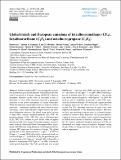| dc.contributor.author | Say, Daniel | |
| dc.contributor.author | Manning, Alistair J | |
| dc.contributor.author | Western, Luke M | |
| dc.contributor.author | Young, Dickon | |
| dc.contributor.author | Wisher, Adam | |
| dc.contributor.author | Rigby, Matthew | |
| dc.contributor.author | Reimann, Stefan | |
| dc.contributor.author | Vollmer, Martin K | |
| dc.contributor.author | Maione, Michela | |
| dc.contributor.author | Arduini, Jgor | |
| dc.contributor.author | Krummel, Paul B | |
| dc.contributor.author | Mühle, Jens | |
| dc.contributor.author | Harth, Christina M | |
| dc.contributor.author | Evans, Brendan | |
| dc.contributor.author | Weiss, Ray F | |
| dc.contributor.author | Prinn, Ronald G | |
| dc.contributor.author | O'Doherty, Simon | |
| dc.date.accessioned | 2021-10-21T15:09:21Z | |
| dc.date.available | 2021-10-21T15:09:21Z | |
| dc.date.issued | 2021 | |
| dc.identifier.uri | https://hdl.handle.net/1721.1/133074 | |
| dc.description.abstract | Perfluorocarbons (PFCs) are amongst the most potent greenhouse gases listed under the United Nations Framework Convention on Climate Change (UNFCCC). With atmospheric lifetimes on the order of thousands to tens of thousands of years, PFC emissions represent a permanent alteration to the global atmosphere on human timescales. While the industries responsible for the vast majority of these emissions-aluminium smelting and semi-conductor manufacturing-have made efficiency improvements and introduced abatement measures, the global mean mole fractions of three PFCs, namely tetrafluoromethane (CF4, PFC-14), hexafluoroethane (C2F6, PFC-116) and octafluoropropane (C3F8, PFC-218), continue to grow. In this study, we update baseline growth rates using in situ high-frequency measurements from the Advanced Global Atmospheric Gases Experiment (AGAGE) and, using data from four European stations, estimate PFC emissions for northwest Europe. The global growth rate of CF4 decreased from 1.3 ppt yr-1 in 1979 to 0.6 ppt yr-1 around 2010 followed by a renewed steady increase to 0.9 ppt yr-1 in 2019. For C2F6, the growth rate grew to a maximum of 0.125 ppt yr-1 around 1999, followed by a decline to a minimum of 0.075 ppt yr-1 in 2009, followed by weak growth thereafter. The C3F8 growth rate was around 0.007 ppt yr-1 until the early 1990s and then quickly grew to a maximum of 0.03 ppt yr-1 in 2003-2004. Following a period of decline until 2012 to 0.015 ppt yr-1, the growth rate slowly increased again to ∼ 0.017 ppt yr-1 in 2019. We used an inverse modelling framework to infer PFC emissions for northwest Europe. No statistically significant trend in regional emissions was observed for any of the PFCs assessed. For CF4, European emissions in early years were linked predominantly to the aluminium industry. However, we link large emissions in recent years to a chemical manufacturer in northwest Italy. Emissions of C2F6 are linked to a range of sources, including a semi-conductor manufacturer in Ireland and a cluster of smelters in Germany's Ruhr valley. In contrast, northwest European emissions of C3F8 are dominated by a single source in northwest England, raising the possibility of using emissions from this site for a tracer release experiment. | en_US |
| dc.language.iso | en | |
| dc.publisher | Copernicus GmbH | en_US |
| dc.relation.isversionof | 10.5194/ACP-21-2149-2021 | en_US |
| dc.rights | Creative Commons Attribution 4.0 International license | en_US |
| dc.rights.uri | https://creativecommons.org/licenses/by/4.0/ | en_US |
| dc.source | Copernicus Publications | en_US |
| dc.title | Global trends and European emissions of tetrafluoromethane (CF 4 ), hexafluoroethane (C 2 F 6 ) and octafluoropropane (C 3 F 8 ) | en_US |
| dc.type | Article | en_US |
| dc.identifier.citation | Say, Daniel, Manning, Alistair J, Western, Luke M, Young, Dickon, Wisher, Adam et al. 2021. "Global trends and European emissions of tetrafluoromethane (CF 4 ), hexafluoroethane (C 2 F 6 ) and octafluoropropane (C 3 F 8 )." Atmospheric Chemistry and Physics, 21 (3). | |
| dc.contributor.department | Massachusetts Institute of Technology. Center for Global Change Science | en_US |
| dc.contributor.department | Massachusetts Institute of Technology. Department of Earth, Atmospheric, and Planetary Sciences | en_US |
| dc.relation.journal | Atmospheric Chemistry and Physics | en_US |
| dc.eprint.version | Final published version | en_US |
| dc.type.uri | http://purl.org/eprint/type/JournalArticle | en_US |
| eprint.status | http://purl.org/eprint/status/PeerReviewed | en_US |
| dc.date.updated | 2021-09-21T16:45:18Z | |
| dspace.orderedauthors | Say, D; Manning, AJ; Western, LM; Young, D; Wisher, A; Rigby, M; Reimann, S; Vollmer, MK; Maione, M; Arduini, J; Krummel, PB; Mühle, J; Harth, CM; Evans, B; Weiss, RF; Prinn, RG; O'Doherty, S | en_US |
| dspace.date.submission | 2021-09-21T16:45:22Z | |
| mit.journal.volume | 21 | en_US |
| mit.journal.issue | 3 | en_US |
| mit.license | PUBLISHER_CC | |
| mit.metadata.status | Publication Information Needed | en_US |
